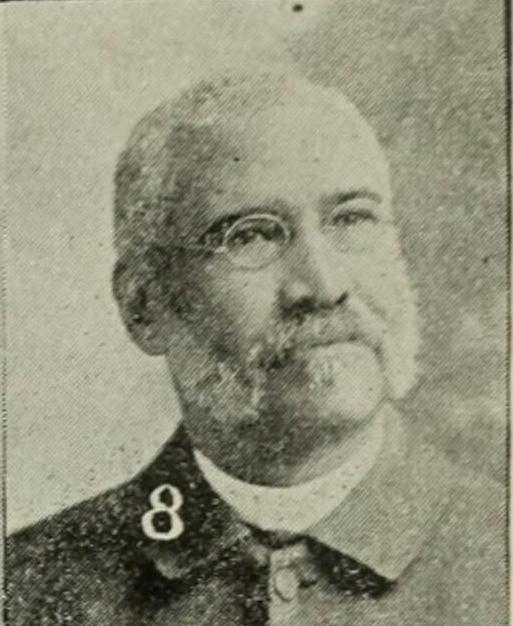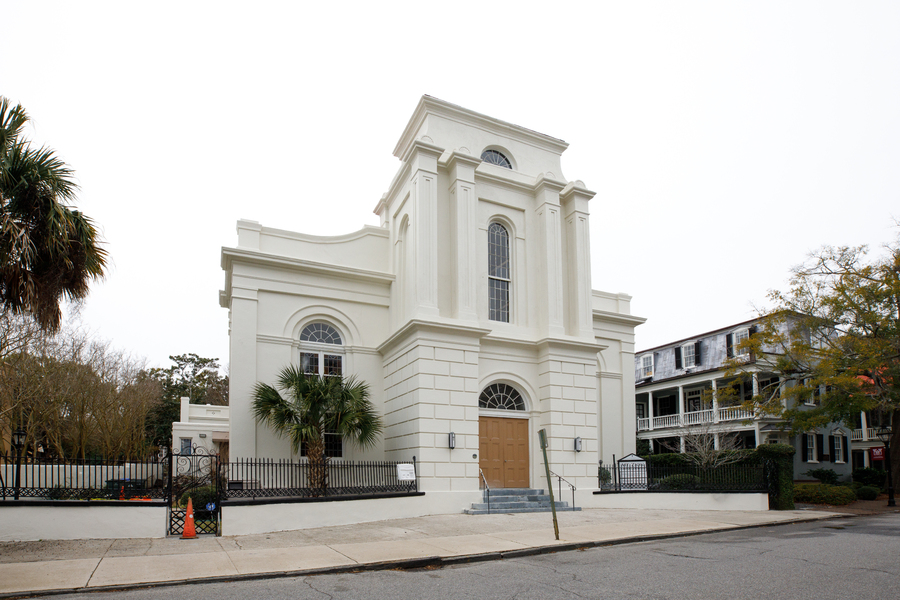Mt. Zion AME Church, 5 Glebe Street
An example of bridging the gap for the rest of the country

The building at 5 Glebe Street was designed by Edward C. Jones and constructed between 1847 and 1848. Jones was influenced by the simplified classicism seen in English churches of the same period. There are only a few church buildings in Charleston built in this style.
The building at 5 Glebe Street was designed by Edward C. Jones and constructed between 1847 and 1848. Jones was influenced by the simplified classicism seen in English churches of the same period. There are only a few church buildings in Charleston built in this style. The land had been part of the glebe lands for St. Philip’s church for many years. (Glebes were property donated to the parish as a source of income, and where the priest could raise his crops, keep a garden, and raise livestock.) In 1797 the parish subdivided the glebe. It sold some lots and leased others for long terms. In 1847 the original leaseholder of the lot where Mt. Zion is now located gave the lease to Glebe Street Presbyterian Church, and the latter organization built a church on the property. Glebe Street Presbyterian later sold the lot and building to Zion Presbyterian.
The founder of the Methodist Church, John Wesley, was one of England’s most vocal abolitionists. In 1771 he sent Francis Asbury to the United States as a missionary. When slave owners decided to convert to Methodism, they were required to free their slaves. Wesley also expected every man in the church to have equal opportunity for involvement in ministry and leadership of the entire congregation regardless of race. That attracted many Blacks, free and enslaved, to Methodism.
Over time, however, American racism and slavery eroded the promised freedom and equality. Black members grew tired of second-class treatment and began leaving white Methodist churches starting in the late eighteenth century, first in Philadelphia and then in Charleston in 1791. These actions led to the formation of the African Methodist Episcopal Church. In Charleston, Black Methodists formed the Bethel Circuit Church and constructed a wood frame church in Hampstead Village. When the city ordered the church torn down after the 1822 trial of lay minister Denmark Vesey, the congregation sold the lumber. They used the money to rebuild the church once the furor over Vesey’s foiled rebellion died down. Southern whites feared that Black churches were places where uprisings were planned, and slaves illegally taught how to read. In 1834 the state passed a law banning Black churches, forcing these churches underground. The AME Church stayed organized enough to reorganize at the end of the Civil War quickly and adopt the name Emanuel for its first congregation..
In 1865 the congregation built a wood frame building at 110 Calhoun Street, the site where the current masonry building of “Mother Emanuel” now stands. In less than fifteen years, they had outgrown the building, and church leaders began to discuss how to remedy the situation. The leadership and congregation split into two camps. One group wanted to purchase land for the construction of a new building, and the other wanted to stay put. Reverend Norman B. Sterrett tried to split the baby down the middle. First, the two groups would unite to rebuild the current building. Then they would work together to purchase a new piece of property and construct a new building. Sterrett secured the assistance of a white man to purchase two lots on the corner of Rutledge Avenue and Montague Street. Sterrett had a white agent buy them to ensure area residents didn’t find out that the lots were to be purchased by a Black church and thus attempt to block the sale.
At the same time, Zion Presbyterian Church and Westminster Presbyterian Church had both declined in membership, so they decided to merge their congregations, but neither wanted to leave their building. It was agreed that both buildings would go on the auction block on the same day at the same time. The building that received the bid closest to the asking price would be sold. One Westminster member who lived near the corner of Rutledge and Montague came up with a plan to make Westminster’s building the home of the merged congregation and remove the planned Black church from his neighborhood. If Sterrett agreed to bid on the Zion Presbyterian building, he and his neighbors would buy the lots from Emanuel. Sterrett agreed and again engaged a white agent to stand in his stead at the auction. The scheme worked, and on October 16, 1882, Sterrett received the keys and named the building Mount Zion A.M.E.; this became the first Black congregation in Charleston to worship in a masonry building.
St. Philip’s Church immediately sued to stop the sale. It claimed the lot belonged to the church them since the land had been leased in the past, not sold. (In 1866 Glebe Street Presbyterian sold the building and property to Zion Presbyterian Church and, in turn, Mount Zion A.M.E. purchased the church and land from Zion Presbyterian at auction.) Sterrett knew there could be the chance of some kind of legal action, so he was careful to ensure that Zion Presbyterian would protect them if a legal situation occurred. Mount Zion’s legal battle for their new home lasted two years.
Mount Zion’s acquisition and retention of the property was another example of what Black Charlestonians were willing to do to worship God their own way. Black churches were no longer illegal, but racist attitudes and actions kept them from worshiping where they wanted. Rev. Sterrett skillfully maneuvered past the obstacles created to subjugate Blacks to acquire space for his congregation to grow. One hundred thirty-seven years later, the leadership of Mount Zion continues the work of lifting the limits placed on Black people and bridging the gap between the races. Rev. Kylon Middleton, a College of Charleston alumnus, was appointed head of the Illumination Project in 2018. Born in the aftermath of the racially motivated shooting at Emanuel AME, the goal of the project is to build bridges between the Black and white communities and between the Black community and the local police. Mount Zion has partnered with the mostly white Grace Church Cathedral for book talks and ways to bring the community together. The work of Mount Zion has become an example for the rest of the country.
Images


